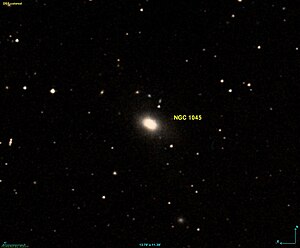NGC 1045
| Galaxy NGC 1045 |
|
|---|---|

|
|
| AladinLite | |
| Constellation | whale |
|
Position equinox : J2000.0 , epoch : J2000.0 |
|
| Right ascension | 02 h 40 m 29.1 s |
| declination | -11 ° 16 ′ 39 ″ |
| Appearance | |
| Morphological type | SA0- / pec? |
| Brightness (visual) | 12.4 mag |
| Brightness (B-band) | 13.4 mag |
| Angular expansion | 1.6 ′ × 1.2 ′ |
| Position angle | 40 ° |
| Surface brightness | 13.2 mag / arcmin² |
| Physical data | |
| Redshift | 0.015497 +/- 0.000030 |
| Radial velocity | 4646 +/- 9 km / s |
|
Stroke distance v rad / H 0 |
(206 ± 14) · 10 6 ly (63.3 ± 4.4) Mpc |
| history | |
| discovery | William Herschel |
| Discovery date | November 28, 1785 |
| Catalog names | |
| NGC 1045 • PGC 010129 • MCG -02-07-059 • 2MASX J02402912-1116391 • GC 586 • H II 488 • h 253/2491 • GALEX ASC J024029.06-111638.2 • LDCE 177 NED015 | |
NGC 1045 is an elliptical galaxy of Hubble type E / S0 in the constellation Cetus south of the celestial equator . It is estimated to be 206 million light years away from the Milky Way and has a diameter of around 95,000 ly.
In the same area of the sky are the galaxies NGC 1011 , NGC 1013 , NGC 1017 , IC 247 .
The object was discovered on November 28, 1785 by William Herschel .
